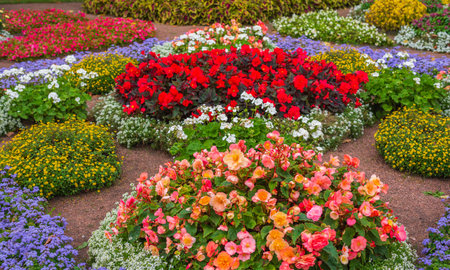Introduction to Raised Beds and Planters in British Gardening
Raised beds and planters have become a defining feature of British gardens, blending tradition with practicality across centuries. These structures, whether crafted from timber, stone, or more contemporary materials, are essentially elevated plots or containers used for cultivating flowers, vegetables, and herbs. Their enduring presence speaks to their adaptability and vital role in the gardening life of the UK. In essence, raised beds lift soil above ground level, often framed by wooden boards or bricks, while planters are movable vessels ranging from classic terracotta pots to ornate troughs. Both serve as solutions to Britain’s varied climate and diverse soil types, offering better drainage, easier weed management, and improved accessibility—especially valuable in small city gardens or for those less able to stoop and dig. Over generations, these features have not only enhanced plant health but also contributed aesthetically to the quintessentially British garden, embodying both function and charm.
2. Medieval Roots: The Origins of Raised Beds in Monastic and Manor Gardens
To truly appreciate the raised beds and planters so beloved in today’s British gardens, we must travel back to the medieval period, when the earliest examples began to take shape within the protective walls of monasteries and grand manor houses. These spaces, often referred to as “walled kitchen gardens,” played a crucial role not only in providing sustenance but also in shaping horticultural practices that endure to this day. In those days, monks and estate gardeners faced many challenges: poor soil quality, harsh weather, and the ever-present risk of pests and disease. Their solution was ingeniously simple yet highly effective—constructing raised beds using timber, wattle fencing, or even stone, elevating precious crops above ground level for better drainage, warmth, and ease of tending.
Within these enclosed gardens, order and productivity went hand-in-hand with beauty and spiritual symbolism. Beds were arranged in neat geometric patterns—often rectangular or square—and edged by low walls or woven hurdles. This design not only made it easier to manage herbs, vegetables, and medicinal plants but also reflected a sense of discipline and harmony prized by both monastic communities and their noble counterparts. Raised beds allowed for improved soil management; layers of manure, compost, and topsoil could be added or replaced without disturbing established pathways—a feature that would become a hallmark of English garden design for centuries to come.
| Feature | Monastic Gardens | Manor Gardens |
|---|---|---|
| Materials Used | Wattle fencing, timber frames | Stone edges, brickwork |
| Main Purpose | Cultivation of medicinal herbs & food crops | Production for household kitchens & display |
| Layout Style | Geometric grids, symbolic cross shapes | Ornamental parterres mixed with utility beds |
| Protection Methods | Cloistered walls & covered walkways | High boundary walls & formal paths |
The influence of these early raised beds extended beyond mere practicality; they fostered a culture of experimentation and stewardship. The walled gardens acted as microclimates, where exotic species brought back from distant lands could be nurtured alongside native varieties. This spirit of innovation remains at the heart of British gardening traditions. As we look back on these medieval roots, it becomes clear that the humble raised bed was never just about growing food—it was about creating order from chaos, nurturing body and soul alike within the sheltering embrace of carefully tended earth.
![]()
3. Georgian Stately Homes: Raised Beds for Display and Utility
The Georgian era, spanning from the early 18th to the early 19th century, brought with it a sweeping transformation in British garden design. This was a time when grand estates dotted the countryside, each competing to showcase both refined taste and agricultural prowess. Raised beds, or “parterres,” became a prominent feature within these stately homes—not just as practical solutions for growing produce, but as elegant elements of landscape artistry.
Georgian landscape designers like Capability Brown and Humphry Repton were instrumental in shaping the aesthetics of these great gardens. They introduced sweeping lawns and naturalistic parklands, but closer to the house, order reigned supreme. Here, raised beds were meticulously arranged in geometric patterns to create visually striking kitchen gardens—known as walled gardens—that supplied households with fresh fruit, vegetables, and herbs year-round.
For the gentry, these raised beds served a dual purpose. On one hand, they showcased horticultural skill and abundance; on the other, they provided practicality by improving drainage and soil quality—vital in Britain’s often damp climate. The slightly elevated soil also helped extend the growing season, protecting tender plants from frost. In true British fashion, function walked hand-in-hand with form.
Wander around any surviving Georgian estate today—say Chatsworth or Holkham Hall—and you’ll see evidence of this tradition. Ornamental box hedges outlining vegetable plots, brick-edged beds neatly compartmentalising crops, and gravel paths separating each section for easy access—all designed with an eye for symmetry and efficiency. These gardens were living proof that utility could be beautiful, a lesson many modern gardeners still cherish.
4. Victorian Innovators: Allotments, Urban Gardening, and New Materials
The Victorian era, stretching from 1837 to 1901, marked an extraordinary chapter in the evolution of UK gardens, particularly with respect to raised beds and planters. As cities like London, Manchester, and Birmingham boomed with new industries, thousands flocked from rural villages to urban centres. This rapid urbanisation brought both challenges and opportunities for gardening enthusiasts determined to hold onto a patch of green in the midst of smoky cityscapes.
Allotments—shared plots of land provided for the working class—became a hallmark of Victorian life. These spaces were often divided into manageable sections using raised beds constructed from whatever materials were at hand. Bricks salvaged from demolished buildings, locally quarried stone, or even timber from old railway sleepers found new purpose as sturdy borders for productive vegetable patches.
Victorian gardeners were nothing if not inventive. Their fascination with science fuelled experimentation with soil composition, drainage, and plant nutrition—all areas where raised beds excelled. The controlled environment of a planter or bed allowed for improved yields and healthier crops, which was especially important given the limited space and poorer urban soils.
Common Raised Bed Materials in Victorian Urban Gardens
| Material | Source/Availability | Advantages |
|---|---|---|
| Reclaimed Brick | Urban demolition sites | Durable, good insulation |
| Yorkshire Stone | Local quarries | Aesthetic appeal, longevity |
| Timber Sleepers | Railway industry surplus | Easy to shape and move |
| Cinder Blocks | Industrial by-product | Cheap, easy to stack |
This period also witnessed the rise of decorative planters on terraces and balconies, crafted from cast iron or glazed terracotta—materials that showcased the Victorians’ flair for ornamentation as well as their resourcefulness. Whether in communal allotments or private townhouses, these innovations transformed how people engaged with gardening in Britain’s rapidly changing cities.
The legacy of Victorian ingenuity can still be found today, not only in the enduring popularity of allotments but also in the eclectic mix of materials and practical designs seen in modern British gardens. Their spirit reminds us that even amidst change and challenge, there is always room for creativity—and a few flourishing lettuces—in any corner of our lives.
5. Post-war Britain: Raised Beds for Resilience and Community
During the tumultuous years of the Second World War, British gardens underwent a transformation that would shape the landscape of suburban and working-class plots for generations. The government’s “Dig for Victory” campaign was a clarion call to every household, urging people to convert lawns, flowerbeds, and even public parks into productive vegetable patches. It was during this era that raised beds became more than a horticultural convenience—they became a symbol of resilience and communal spirit.
With food rationing tightening belts across the country, resourceful Britons took to their spades with renewed vigour. Raised beds were favoured not just for their practicality—offering improved drainage on heavy soils and making it easier to tend crops—but also for their efficiency in small urban spaces. Gardeners made use of whatever materials were at hand: old railway sleepers, bricks salvaged from bombed buildings, or even simple wooden planks. These beds helped maximise yields, conserve precious resources, and foster neighbourly collaboration as communities shared seeds, tools, and advice over garden fences.
In post-war Britain, as peace returned but austerity lingered, the culture of self-sufficiency continued. Raised beds became a common sight in allotments and back gardens alike, providing families with fresh produce long after rationing ended. For many working-class households in towns like Birmingham or Manchester, tending a raised bed was both an economic necessity and a point of pride—a tradition handed down through generations.
This period cemented the raised bed as an enduring feature of British gardening. The lessons learned from wartime hardship carried forward: growing your own food wasn’t just about survival; it was about community, health, and the simple satisfaction of nurturing life from the soil. Even today, echoes of that era can be seen in community gardens up and down the country, where raised beds continue to bring people together in pursuit of resilience and shared bounty.
6. Modern Trends: Sustainable Gardening and Contemporary Design
In recent years, British gardens have witnessed a modern revival of raised beds and planters, reflecting both time-honoured traditions and contemporary priorities. While the Victorian passion for neatness and productivity still echoes in today’s plots, there is now a distinct emphasis on sustainability and accessibility that defines the 21st-century gardening ethos.
Sustainability Takes Centre Stage
The UK’s focus on sustainable living has inspired gardeners to revisit the raised bed with fresh eyes. Reclaimed timber, repurposed bricks, and even recycled plastic have become popular choices for constructing beds, helping to reduce waste and environmental impact. Many gardeners also adopt organic practices—composting kitchen scraps and using peat-free soil mixes—to ensure their raised beds nurture not only plants but also local wildlife, echoing a growing awareness of ecological balance in the British countryside.
Accessibility for All Gardeners
Raised beds offer improved accessibility, making gardening more inclusive for people with mobility challenges or limited space. The tradition of allotment gardening has merged beautifully with these modern approaches, allowing older generations to continue tending their beloved vegetables without the strain of kneeling or bending. Urban gardeners—particularly in cities like London and Manchester—have also embraced compact planters on balconies and patios, proving that you don’t need a grand country estate to enjoy homegrown produce.
Blending Tradition with Innovation
Contemporary garden design in the UK often blends classic aesthetics with inventive touches. You’ll find wattle-edged raised beds nodding to medieval practices alongside sleek corten steel planters that suit minimalist townhouses. Community gardens across Britain now incorporate pollinator-friendly flowers within raised beds, supporting bees while fostering neighbourhood connections—a modern twist on the communal spirit seen in wartime ‘Dig for Victory’ campaigns.
As we look to the future, it’s clear that raised beds and planters will remain at the heart of British gardening, cherished for their practicality and their ability to adapt to changing times. Whether crafted from weathered oak or upcycled scaffolding boards, these features continue to honour UK gardening heritage while embracing innovation—a true testament to the enduring spirit of British gardens.


